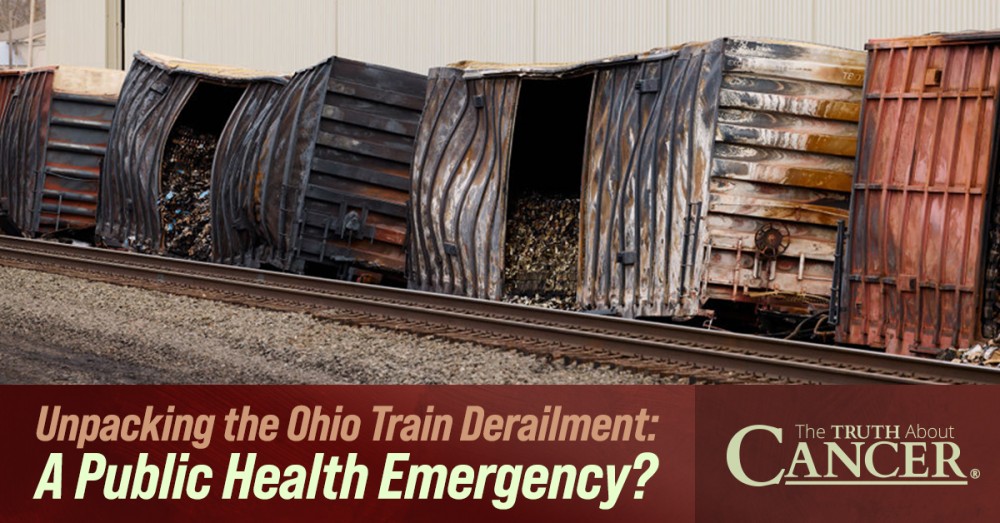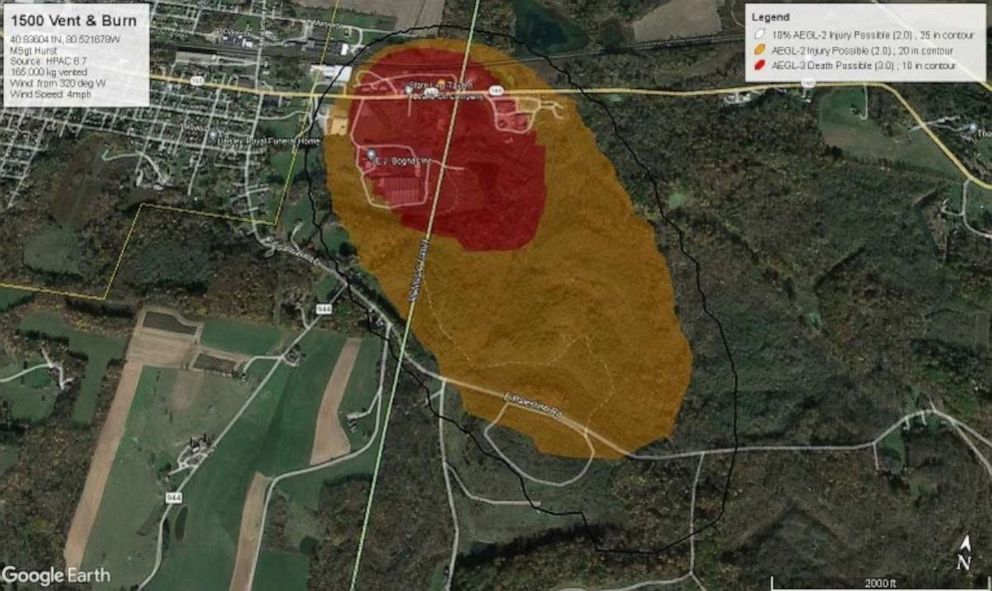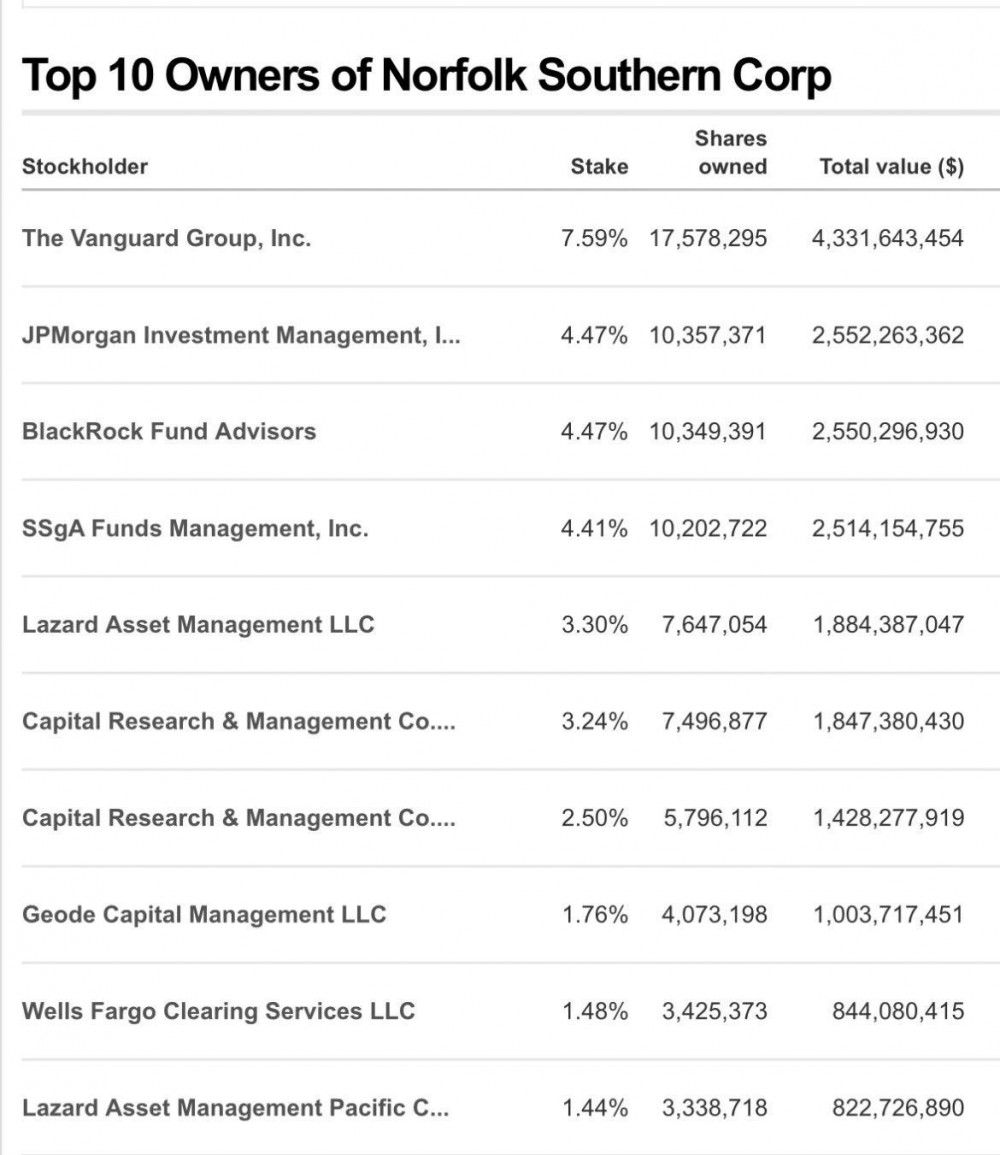On February 3rd, a train went off the rails in East Palestine, Ohio – roughly an hour northwest of Pittsburgh, PA. At least 50 cars of a Norfolk Southern train went off the track, causing a fire that lasted for several days. This is of major concern because many of the cars were carrying toxic chemicals, including vinyl chloride, butyl acrylate, phosgene, ethylhexyl acrylate, and hydrogen chloride.
Further in this article is a breakdown of the health risks posed by these chemicals.
A huge fire erupted from the derailment, sending thick billowing smoke into the sky and over the town. Over 2,000 residents were evacuated from the area after Ohio Governor Mike DeWine raised alarms about a possible explosion. Most residents have since returned home.
The Biden administration turned down a request for federal disaster assistance from Governor DeWine. FEMA told Ohio’s state government that it was not eligible for disaster assistance to help the community recover from the toxic spill, said Dan Tierney, a spokesperson for DeWine. Tierney explained that FEMA believed the incident didn’t qualify as a traditional disaster, such as a tornado or hurricane, for which it usually provides assistance.
“The DeWine Administration has been in daily contact with FEMA to discuss the need for federal support, however FEMA continues to tell Governor DeWine that Ohio is not eligible for assistance at this time,” DeWine’s office said in a statement earlier in the day. “Governor DeWine will continue working with FEMA to determine what assistance can be provided.”
Authorities executed a “controlled burn” of the highly flammable vinyl chloride, which is the chemical that had raised the most concern since the event. Authorities conducted a “controlled release and burn” of chemicals from the derailed train.
Officials released a map showing the area downwind from the burn, with Norfolk Southern saying anyone who remains in the red area will be exposed to deadly toxins and anyone in the yellow area could suffer “skin burns and serious lung damage.
“We basically nuked a town with chemicals so we could get a railroad open,” said Sil Caggiano, a hazardous materials specialist. “Out of nowhere, he just started coughing really hard, just shut down, and he had liquid diarrhea and just went very fast,” said resident Taylor Holzer while he explained the mortally ill condition of his foxes.
“Smoke and chemicals from the train, that’s the only thing that can cause it, because it doesn’t just happen out of nowhere,” Holzer said. “The chemicals that we’re being told are safe in the air, that’s definitely not safe for the animals … or people.”
But the danger may be far from over, as the toxic fallout – including air pollutants and water contamination – has yet to be determined. Residents have reported animals like fish, cows, and chickens dropping dead in the area.
The Ohio River, which serves over 10% of the US Population, has reportedly become contaminated due to chemicals from the East Palestine train derailment. The river supplies public drinking water to over 5 million people in addition to industries all the way to West Virginia, affecting over 30 million people who live in the Ohio River Basin.
“We have an extensive monitoring network for organics detection in the Ohio River and along the river basin,” Water Quality Manager Chris Bobay said. “That network is detecting low levels of chemicals associated with the release from the train derailment.”
The spillage of these chemicals into local water courses has led to the death of many fish. The water is believed to have become contaminated and crops and livestock on nearby farms have been destroyed, presumably from the toxic fallout from the explosion.
Environmentalist and consumer advocate Erin Brockovich called on President Joe Biden to do more for the residents of East Palestine following the train derailment and subsequent burn. Brockovich said that she is skeptical of government reports as to the extent of contamination, either in the water or the air from the chemical release.
“I’m trying to gather information on this very serious situation in Ohio involving a train derailment with hazardous chemicals,” Brockovich wrote on Twitter over the weekend. “What I will say is this. Trust your eyes, ears and nose and get the hell out of there if your senses are telling you to.”
“The Biden Administration needs to get more involved in this train derailment now. We are counting on you to break the chain of administration after administration to turn a blind eye,” she later added.
Health Risks
Vinyl Chloride
According to the National Cancer Institute, the general population may be exposed by inhaling contaminated air or tobacco smoke. In the environment, the highest levels of vinyl chloride are found in air around factories that produce vinyl products. If a water supply is contaminated, vinyl chloride can enter household air when the water is used for showering, cooking, or laundry.
Vinyl chloride exposure is associated with an increased risk of a rare form of liver cancer (hepatic angiosarcoma), as well as primary liver cancer (hepatocellular carcinoma), brain and lung cancers, lymphoma, and leukemia.
Vinyl chloride is readily absorbed from the lungs. Its odor threshold is too high to provide an adequate warning of hazardous concentrations, which means you may not be able to smell anything out of the ordinary even if you are exposed.
A 5-minute exposure to airborne concentrations of 8,000 ppm can cause dizziness. As airborne levels increase to 20,000 ppm, effects can include drowsiness, loss of coordination, visual and auditory abnormalities, disorientation, nausea, headache, and burning or tingling of the extremities. Exposure to higher concentrations of vinyl chloride for longer durations can cause death, presumably due to central nervous system and respiratory depression.
Because they have a greater ratio of lung surface area to body weight, children could be at greater risk with even lower concentrations. This seems to be the most dangerous of the chemicals spilled in Ohio.
Butyl Acrylate
Acute exposure to butyl acrylate vapor can cause redness, tearing, and irritation of the eyes, runny nose, scratchy throat, difficult breathing, and redness and cracking of the skin. It can also cause dizziness, headaches, nausea, and vomiting. Repeated or prolonged exposure can cause permanent lung damage.
Phosgene
People’s risk for exposure depends on how close they are to the place where the phosgene was released. If phosgene gas is released into the air, people may be exposed through skin contact or eye contact. They may also be exposed by breathing air that contains phosgene.
If phosgene liquid is released into water, people may be exposed by touching or drinking water that contains phosgene. If phosgene liquid comes into contact with food, people may be exposed by eating the contaminated food.
Phosgene can also cause coughing, a burning sensation in the throat and eyes, watery eyes, blurred vision, difficulty breathing or shortness of breath, nausea, and vomiting. Skin contact can result in lesions similar to those from frostbite or burns Following exposure to high concentrations of phosgene, a person may develop fluid in the lungs (pulmonary edema) within 2 to 6 hours.
Most people who recover after an exposure to phosgene make a complete recovery. However, chronic bronchitis and emphysema have been reported as a result of phosgene exposure.
Ethylhexyl Acrylate
Breathing high levels of Ethyl Acrylate can affect the nervous system causing dizziness, drowsiness, nausea and headache. It can also result in pulmonary edema, which is a medical emergency. Health authorities have identified Ethyl Acrylate as a carcinogen, warning that it should be handled with extreme caution.
Acrylate vapors have been reported to cause drowsiness, lethargy, headache, nausea, convulsions, and respiratory and gastrointestinal irritation. Non-cancerous lesions and inflammation of the nasal mucosa and depressed body weight gain have been observed in rats and mice exposed by inhalation for a chronic duration.
In one study, the swelling of renal tubules and the liver, minor lesions on the liver and lung, and increased kidney weight were reported in rats chronically exposed by inhalation. A 1986 NTP study reported increased incidences of squamous cell papillomas and carcinomas of the forestomach in rats and mice exposed via gavage.
Hydrogen Chloride
Hydrogen chloride can irritate the skin, nose, eyes, throat, and larynx. Exposure to liquid hydrogen chloride may cause frostbite. A clinical study involving 170 firefighters identified HCl from degradation of polyvinyl chloride as an important contributor to respiratory symptoms. One death with hemorrhage, edema, and inflammation of the lungs was reported.
Another study found that residents and a police officer became acutely ill with burning and tearing eyes, burning throats, headache, chest pains, shortness of breath, and flu-like complaints following a leak of 200 gallons of hydrochloric acid from a tanker truck. Twenty four months later, a cohort study indicated that the incidence of neurobehavioral changes and airway obstruction was higher in the exposed population than in a referent group.
Who Is Responsible?
Obviously, Norfolk Southern will have to answer for this environmental calamity. But some of the railroad’s biggest owners (including JP Morgan, BlackRock, and Wells Fargo) have an extensive history of manipulating regulatory bodies to protect their financial interests.
A few years ago, the company helped kill a federal safety rule aimed at upgrading the rail industry’s Civil War-era braking systems. Documents show that when current transportation safety rules were first created, a federal agency sided with industry lobbyists and limited regulations governing the transport of hazardous compounds.
The decision effectively exempted many trains hauling dangerous materials — including the one in Ohio — from the “high-hazard” classification and its more stringent safety requirements. Even though the train burst into 100-foot flames upon derailing and carried dangerous toxins that triggered a fireball when incinerated, federal officials said that the train was not being regulated as a “high-hazard flammable train.”
Amid the lobbying blitz against stronger transportation safety regulations, Norfolk Southern paid executives millions and spent billions on stock buybacks — all while the company shed thousands of employees despite warnings that understaffing is intensifying safety risks. Norfolk Southern officials also fought off a shareholder initiative that could have required company executives to “assess, review, and mitigate risks of hazardous material transportation.”
in 2014 proposed improving safety regulations for trains carrying petroleum and other hazardous materials. However, after industry pressure, the final measure ended up narrowly focused on the transport of crude oil and exempting trains carrying many other combustible materials, including vinyl chloride.
After rail industry donors delivered more than $6 million to GOP campaigns, the Trump administration — backed by rail lobbyists and Senate Republicans — rescinded a rule aimed at making better braking systems widespread on the nation’s rails. And those brakes are likely a big reason for the uptick in train derailments.
Traditional train braking systems use pneumatic valves to control and generate brake applications on the cars along the length of the train. Because the engineer controls the flow of air into and out of the brake pipe from the locomotive, it can take up to two minutes for a commanded brake application to propagate to the back of a long freight train. This uneven braking can cause significant forces to build up between the cars in a train.
This method of controlling the brakes on freight and passenger cars has remained virtually unchanged since its invention by George Westinghouse in 1868.
Regulators killed provisions requiring rail cars carrying hazardous flammable materials to be equipped with electronic braking systems to stop trains more quickly than conventional air brakes. Norfolk Southern had previously touted the new technology — known as Electronically Controlled Pneumatic (ECP) brakes — for its “potential to reduce train stopping distances by as much as 60 percent over conventional air brake systems.”
But the company’s lobby group nonetheless pressed for the rule’s repeal, telling regulators that it would “impose tremendous costs.”
“Would ECP brakes have reduced the severity of this accident? Yes,” Steven Ditmeyer, a former senior official at the Federal Railroad Administration (FRA), told reporters. “The railroads will test new features. But once they are told they have to do it… they don’t want to spend the money.”
Once again, we see that greed and access to centralized government bodies results in calamity for the public. Norfolk didn’t want to spend money on new technology or safety measures. Their high-profile investors (who own billions of dollars’ worth of Norfolk stock) are deeply embedded in our governmental systems, pouring copious amounts of money into campaigns with the understanding that their interests will be protected.
What Precautions Can We Take?
These chemicals spilled and burned. They are in the air, they are in the ground, and they are in the water. The true extent of this disaster won’t be known for some time. Reports of dead pets, livestock, and aquatic animals demonstrate that the fallout is real. How far that will spread and the full impact is something that’s still developing.
We don’t want to be alarmists. But we also don’t want to minimize what could very well be the worst environmental disaster in American history. There are some steps you can take if you live in the area near the crash. If you’re within a 20-mile radius of the crash site, you may want to consider staying with friends or relatives for a while longer.
Health authorities have said that it’s safe for residents to return, but if the last 3 years have taught us anything, it’s that the government is not looking out for our best interests. We only get one body in this life, so do what you think is best for you and your family.
For those of you who are close to the crash site, air toxicity is a very real concern. Utilizing air filters and ensuring good ventilation can go a long way in reducing your risk. Remember, vinyl chloride doesn’t have an odor that you can detect, so don’t just trust your nose.
For the 30 million people who get their water from the Ohio River Basin (as shown in the map above), you’ll almost certainly want to make sure that you’re employing water filtration – especially for drinking water.
There are two main methods that can be used to remove vinyl chloride from water, including:
1 | Activated Carbon Filtration: Activated carbon is a highly porous material that can adsorb organic contaminants, including vinyl chloride. Water can be passed through activated carbon filters to remove vinyl chloride.
2 | Reverse Osmosis: Reverse osmosis is a process that uses a semi-permeable membrane to remove contaminants from water. Water is forced through the membrane, and contaminants, including vinyl chloride, are left behind.
We recently published an article with 8 ways to detoxify with activated charcoal, which is another great way to help flush out the toxins that are found in our environment; from the train wreck or otherwise.
We love you. We started this company because we saw how many people were dying from preventable diseases… and how Big Pharma and government officials were suppressing the information that could prevent it. No matter where you live, remember that your health is entirely in your own hands.
Never let anyone tell you differently.





















I have always appreciated everything you do for the benefits of humanity. You have the guts and the faith and you find the real answers to important questions. I thank you from the bottom of my heart.💜
Thank you for sharing this synopsis on the Ohio Train Derailment I have been following the news on this disaster very closely since it is my former home. I cannot begin to tell you how angry and sad I am …. I can only send prayers for the future for East Palestine and Columbiana County.
Thank you!
I thank you from the bottom of my heart for what you are doing and you are honest people I have been following and supporting since your early beginning . God bless you and your family. You are an inspiration. Love you.
No mention of putting so many eggs in one basket. The time of getting a command from one end to the other wouldn’t be so much of an issue if they weren’t putting so much rolling stock in a consign. But hey, all those gasoline-guzzling cars sitting at crossings waiting for 100+ cars to roll by is more fuel for the EV pushers!